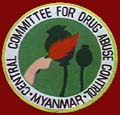 |
16th Destruction Ceremony of Seized Narcotic Drugs, Precursor Chemicals and Paraphernalia |
 |
Nearly 40,000
acres of opium poppy cultivated acreage or
38.63% reduced in three years
Cross-border cooperation
between Myanmar and China enhances mutual trust and understanding leading to
exchange of information and arrest of drug kingpins and traffickers
[
26th June, 2002
]


The 16th
Destruction Ceremony of Seized Narcotic Drugs, Precursor Chemicals and
Paraphernalia, organized by the Central Committee for Drug Abuse Control, was
held in the compound of the Drug Elimination Museum at the corner of Hanthawady
and Kundaw Roads in Kamayut Township at 8 am today, attended by Secre-tary-1 of
the State Peace and Development Council Lt-Gen Khin Nyunt.



Secretary of CCDAC, Deputy
Director-General of MPF Police
Brig-Gen Zaw Win reported on the purpose to hold the Destruction Ceremony.
Also present on
the occasion were Chairman of Yangon Division Peace and Development Council
Commander Maj-Gen Myint Swe, Chairman of CCDAC Minister for Home Affairs Col Tin
Hlaing, Vice-Chairmen Minister for Foreign Affairs U Win Aung and Minister for
Progress of Border Areas and National Races and Development Affairs Col Thein
Nyunt, ministers, the Chief Justice, deputy ministers, departmental heads,
ambassadors, charges d’affaires and military attaches of foreign missions,
resident representatives and officials of the UN agencies, members of CCDAC and
work groups, senior police officers of Myanmar Police Force, U Sein Win of Kyodo
News Agency, Patron U Hla Htwe of Myanmar Foreign Correspondents Club,
Vice-President U Aung Shwe Oo and members, correspondents of foreign news
agencies and broadcasting departments, winners in the short story, article,
poem, painting, cartoon and poster competitions to mark the International Day
Against Drug Abuse and Illicit Trafficking and guests.




Present on the occasion were ambassadors,
charges d’affaires and military attaches of foreign mission,
resident representatives and officials of the UN agencies.
Police Inspector
Ohmma Yin Mie and Police Inspector Ma Pyone of CCDAC of Myanmar Police Force
acted as masters of ceremonies and read out the agenda of the ceremony.
At the ceremony,
on behalf of the Secretary of CCDAC, Deputy Director-General of MPF Police
Brig-Gen Zaw Win reported on the purpose to hold the Destruction Ceremony. He
said:
Today is a
significant day as we once again destroy narcotic drugs, which is a frightful
menace to mankind. You will have the opportunities to witness firsthand that the
Myanmar government, totally aware of the scaring threat, is seriously
undertaking and trying its utmost best to combat these deplorable drugs as a
National Duty.


Heroin and Opium seen at the 16th destruction
ceremony of seized narcotic drug, precursor chemicals and paraphernalia.


Stimulant and methamphetamine seen at the 16th
destruction
ceremony of seized narcotic drug, precursor chemicals and paraphernalia.
Today’s
destruction ceremony is much more meaningful and significant than the previous
destructions of its kind. It differs in such a way that the past destructions
were occasionally held in honour of international conferences held in Myanmar,
visits of dignitaries or to hail commemorative days of the country. However, the
significance defers because it is held on the 26th day of June, commemorating
the International Day Against Drug Abuse and Illicit Trafficking.
Since 1990 up to
present, we have reached to the 16th ceremony of burning seized drugs, precursor
chemicals and paraphernalia in Yangon. In addition to Yangon City, destruction
ceremonies of this kind inclusive of poppy seedlings had been held for twenty
six times in the border areas.

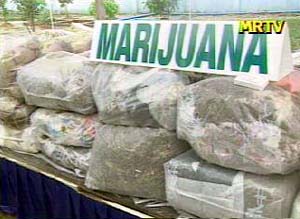
Marijuana seen at the 16th destruction
ceremony of seized narcotic drug, precursor chemicals and paraphernalia.


Packets of Caffein and Ephedrine seen at the
16th destruction
ceremony of seized narcotic drug, precursor chemicals and paraphernalia.
Starting three or
four years back, Myanmar’s anti-drugs campaign has been increasingly gaining
momentum and achieving significant successes. The Baseline Surveys on poppy
cultivation and consumption clearly stands testimony to this trend. According to
surveys between 1998-1999 and the year 2001-2002, opium poppy cultivated area
declined to 39,426 (thirty-nine thousand four hundred and twenty six) acres,
which is a reduction of 38.63%.
Moreover, annual
eradication programmes were able to destroy 14,876 (fourteen thousand eight
hundred and seventy six) acres between 1997-1998 and 2001-2002, an increase of
151.4 per cent. Moreover, UNDCP and INCB Annual Reports also supported the trend
and reported that production has decreased 40 per cent in the past 10 years. The
declining figures clearly shows the results of the Myanmar government’s
unyielding efforts.


Preventive
education talks are carried out to stop poppy cultivation altogether in the
coming 2002-2003 season. As a result of these measures, poppy farmers
voluntarily submitted to the authorities seventy eight thousand eight hundred
and thirty six (78,836) baskets, in other words, one twenty eight thousand seven
hundred and thirty nine point five kilograms (128,739.5) of poppy seeds. You
will be aware that these poppy seeds were burned and destroyed in front of the
public in Lashio, Laukkai, Pinlaung, Kengtung and Loikaw. The burning of these
poppy seeds have been able to prevent seventy eight thousand eight hundred and
thirty six point one nine (78,836.19) acres from cultivation and the production
of thirty four point six nine (34.69) tons of heroin.
Commencing
2002-2003, four Deputy Ministers are assigned to supervise, coordinate with
local authorities to halt poppy cultivation, have toured poppy cultivation
regions of Shan and Kayah States and are executing action plans. Moreover, area
of cultivation has been divided into six regions and teams are formed consisting
CCDAC members, personnel from Ministry of Progress of Border Areas and National
Races and Development Affairs and Myanmar Police Force to supervise, monitor,
give preventive educational talks, evaluate and report back to the CCDAC. For
the distribution of alternative crop seeds to farmers CCADC has provided five
hundred and twenty five thousand kyats to support the programme.
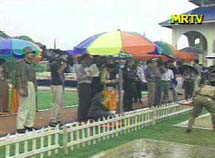
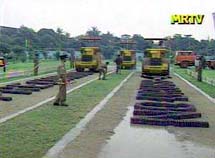

Views bottles of cough syrup with drug potency
being destroyed by rollers at the 16th destruction
ceremony of seized narcotic drugs, precursor chemicals and paraphernalia.
While Myanmar has
limited success in the reduction of opium production, the problem of amphetamine
type stimulants (ATS) has become a new threat. Starting 1997, opium and heroin
seizures declined annually in Myanmar. This trend is also witnessed in China and
Thailand. However, stimulant seizures increased alarmingly from 5.9 million
tablets in 1996 to 32.4 million tablets in 2001. This year, 1.8 million tablets
have been seized up to May.
Regarding
precursor chemicals, nearly ninety thousand litres were seized in 2000. Over
eighteen hundred thousand litres in 2001 and over twenty thousand litres were
seized up to May this year. Ephedrine, Caffeine and other precursor chemicals
essential in manufacturing ATS are not produced in Myanmar but trafficked
illegally from neighbouring countries like China, Yodaya and India. We are aware
neighbouring countries are also placing stringent controls over chemicals to
prevent diversion to illicit channels. However, in spite of these measures,
traffickers are still finding ways and means to traffic chemicals to Myanmar. We
wish to stress here that it is of vital importance to place effective control
mechanisms on precursor chemical production and trade.

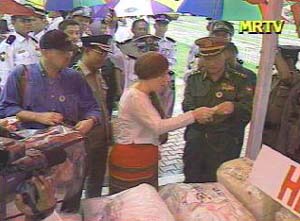
The guests test the seized narcotic drugs
before the destruction.
Regarding
precursor chemicals used in the manufacture of narcotic drugs, the Ministry of
Health on 5th June 2002 issued Notification 1/2002. According to this
Notification, 14 chemicals from Table 1 and 9 chemicals from Table 2 of UN
Convention as well as 2 additional chemicals specific to Myanmar are now under
control, amounting to 25 chemicals controlled in the Union of Myanmar.
Moreover, to
enable financial and assets investigation to take effective action against
financiers behind the lucrative drug business, the “Control of Money Laundering
Law” has been enacted by the State Peace and Development Council on 17th June,
2002.



The guests test the seized narcotic drugs
before the destruction.
The objectives of
the law are to control and take effective action on illicit proceeds of crime,
to prevent influence on the executive, economic and social sectors of the State,
to be in conformity with the international conventions, and to better
international cooperation.
Another
significant development is the increase in cross border cooperation between
Myanmar and China, culminating in the establishment of Border Liaison Offices at
Loije and Chinshwehaw very recently.
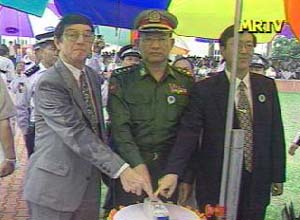
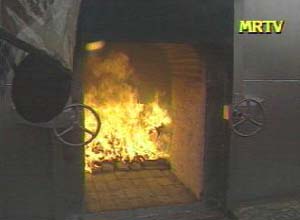
CCDAC Chairman Minister for Home Affairs Col
Tin Hlaing, Ambassador of Australia
Mr Trevor David Wilson and Charge d’Affairs of the Embassy of the People’s
Republic of China
Mr Tang Ying of the US Embassy Ms Priscilla A Clapp press the button to
incinerate the drugs.
This cross border
cooperation has enhanced mutual trust and understanding and subsequently
facilitated smooth exchange of information resulting in the success of
apprehending drug kingpins and traffickers active along the common border.
Altogether there have been 6 cases during 2001 and this year where drug
traffickers, wanted in China and hiding in Myanmar are investigated, arrested
and handed over back to China. It included 2 cases where the Wa authorities
handed over 13 drug traffickers. Only in one case, relevant document and
information were provided while the culprits was charged and prosecuted in
Myanmar. These cases clearly show Myanmar’s sincere spirit of cooperation with
the international community in the fight against drugs.
Another success
story in international law enforcement cooperation was the Fiji drug case where
357 kilos of heroin was seized. With information received from the Australian
Federal Police (AFP), 5 traffickers were arrested and all their assets
confiscated.


Dean of the Diplomatic Crops Lao PDR
Ambassador Mr Ly Bounkham and Charge d’Affairs ai of the US Embassy Ms Priscilla
A Clapp press the button to incinerate the drugs.
Moreover,
successful international cooperation resulted in the arrest of a drug kingpin,
trafficking 116 kilos and 7 million tablets of ATS, which were seized in the
Andaman Sea. Similarly, seizure of 126 pounds of heroin at New York port led to
the successful investigation and arrest of traffickers followed by confiscation
of their assets.
As regards law
enforcement, Myanmar has been undertaking serious actions domestically as well
as in close cooperation with neighbour countries, conducting cross border
meetings alternately for exchanging information and actions to be taken against
illicit trafficking of drugs.

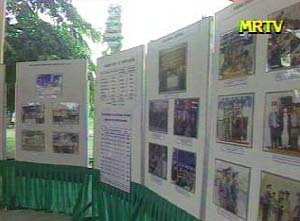
Secretary-1 and party,
the diplomats, the resident representatives of
UN agencies and officials inspected the documentary photos.


I wish to take
this opportunity to strongly stress to the international community that Myanmar,
in the fight against drugs has not received any international assistance
whatsoever, but relying mostly on our own resources and efforts with guidance of
the leaders of the government on strategy and tactics.
In conclusion, I
would like to present the list of drugs, which are going to be destroyed today:
Opium |
3,027 |
kilos; |
Heroin |
240 |
kilos; |
Marijuana |
434.253 |
kilos; |
ATS tablets |
34,946,966 |
Nos; |
Ephedrine tablets |
4,050,947 |
Nos; |
Ephedrine powder |
2,865.705 |
kilos; |
May I also
invited all of you to come down and check the drugs for yourself the
authenticity of the drugs before setting them on fire.
Then, bottles of
cough syrup with drug potency were destroyed by rollers.
Afterwards, the
ambassadors, the charges d’affaire, the military attaches, the resident
representatives of UN agencies, officials and guests tested the narcotic drugs
to be burnt.
Next, CCDAC
Chairman Minister for Home Affairs Col Tin Hlaing, Ambassador of Australia Mr
Trevor David Wilson, Charge d’Affaires of the Embassy of the People’s Republic
of China Mr Tang Ying, Dean of the Diplomatic Corps Lao PDR Ambassador Mr Ly
Bounkham and Charge d’Affaires ai of the US Embassy Ms Priscilla A Clapp pressed
buttons to incinerate the narcotic drugs.



Then, the
Secretary-1 and party, the diplomats, the resident representatives of UN
agencies and officials inspected the documentary photos on implementation of the
New Destiny Project, destruction ceremonies of poppy seeds handed over by local
farmers in Shan State, cultivation of opium substitution crops in Wa region and
handing over of culprits who related to drug cases from Myanmar to China.
Later, the
Secretary-1 cordially met the Ambassadors, the Charges d’Affaire, Military
Attaches and guests.